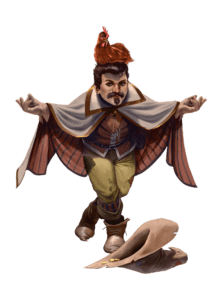
Roleplaying in a game is one of the most effective ways a player can interface with their character and immerse themselves into the world of the game. A common concern among newer players however, is that they don’t believe they can think on their feet, so they can’t roleplay in what they believe is a meaningful way.
Luckily, it’s easy to cultivate improvisation skills! The dirty secret of improv is that you can practice it. You’re at the table anyway, so try these games and tools to improve your skills.
Catch up on all installments of Improv Proficiency!
With the tools and techniques introduced so far, you can construct solid scenes with your fellow players (see Improv Proficiency 1: Using LARCH) and roleplay within them in constructive and cooperative ways (see Improv Proficiency 2: Working Together).
Remember, a scene is any moment of a game in which roleplaying is in the forefront. With these fundamentals in mind, you and your fellow players can learn to introduce fun, unexpected twists into your scenes and take your improvisation skills to the next level.
Layers of Game
The Layers of Game is an important concept for improvising scenes. The top layer of the game in this context is the TTRPG you are playing with your friends. It has concrete rules for the dice you roll and actions you are allowed to take within the game.
This game is the framework in which the second layer of the game exists: the encounters you and your fellow players interact with. Exploration, combat, and social encounters are each their own smaller game within the TTRPG. Each one has different types of objectives you try to reach and different strategies you can use to complete them.
Inside each of these encounters is the third layer of the game: the scenes that you improvise with your fellow players. Each layer of the game has a direct effect on the one above it. The scene affects the encounter, and the encounter affects the TTRPG.
Understanding the effect that one layer of the game has on another gives you a better understanding of how your choices can potentially influence others. Staying aware of the effect your improv decisions can have helps you become a more mindful and considerate improviser.
Making the Fourth Layer
Following the logic of the layers of game, the fourth layer should exist within each individual scene that you play out with the other people at the table. Here, we truly see the fun of improvising with others, since the fourth layer of the game can look like anything (as long as you abide by LARCH to make it feel authentic). In essence, you are looking to create and play some sort of minigame with your fellow players inside of a scene.
The easiest way to do this, and to get the ball rolling on a brand new scene in general, is by finding some common ground with the other players participating in the scene. A simple way to do this is to work together to establish LARCH while remaining in character.
The First Unusual Thing
You can create several types of minigames in a scene. One is called The First Unusual Thing. The first unusual thing is anything in a scene that you think is odd or interesting. When the first unusual thing comes up, repeat it in character to draw attention to it, clueing in the other players. If another player identifies the first unusual thing and attempts to communicate to you in character, repeat it back to them in character, confirming that you spotted it as well.
Player 1: Look upon my legendary blade. It was crafted by the wisest of gnomes deep in the forest.
Player 2: You’re saying gnomes made this sword? (signaling to other players the first unusual thing)
Player 3: Gnomes made your sword?! (acknowledging the first unusual thing pointed out by Player 2)
With the first unusual thing identified, the minigame within the scene is to have your roleplay choices directly reference it rather than something random. This gets players on the same wavelength quicker and can give more hesitant roleplayers a clearer, more concrete goal to work towards.
Exercise: What’s That Thing You Always Do?
This short exercise, which can be done with as few as two people, can help you practice the format of finding the first unusual thing. You and another player begin a conversation as if you were friends who haven’t seen each other in years. Once LARCH is established in character, one player asks the other “Hey, what’s that thing you always do?”, implying that they have forgotten. The other player must make up a strange quirk that they used to have/do. The first player then states the quirk (the first unusual thing) and adds to it.
Player 1: It’s been so long since we’ve seen each other after high school graduation.
Player 2: Hey, what’s that thing you always used to do during lunch?
Player 1: Oh, you mean when I used to put straws up my nose? (establishing the first unusual thing)
Player 2: Yeah! And then you would stand up and say “I’m a walrus!” (acknowledging the first unusual thing and adding to it)
Once the first unusual thing has been identified and built upon, start a new scene and switch who establishes and who acknowledges.
Try this exercise using one of these first unusual things to get started:
- You always break out into song at the worst times.
- You don’t believe in the number 4.
- You are convinced you are a bird.
For more insight into how the games are played and made, told by the pros, check out Kobold Guides!
The Kobold Guide to Worldbuilding gets you inside info on making your world more fun and real.
The Kobold Guide to Gamemastering gives you tips and structure for upping for GM game!
And there are many more, waiting for you!
